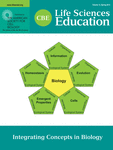Addressing the Challenge of Diversity in the Graduate Ranks: Good Practices Yield Good Outcomes
Abstract
In this paper, we examine the impact of implementing three systemic practices on the diversity and institutional culture in biomedical and public health PhD training at Brown University. We hypothesized that these practices, designed as part of the National Institutes of Health–funded Initiative to Maximize Student Development (IMSD) program in the Division of Biology and Medicine, would have a positive effect on underrepresented minority (URM) recruitment and retention and objective measures of student success. These practices include: 1) develop strategic partnerships with selected undergraduate institutions; 2) provide a personalized education program of student support and skill-based modules to supplement discipline-based course work; and 3) transform institutional culture by engaging faculty in supporting diversity-related goals and practices. Data comparing URM numbers and key academic milestones before and after implementation of IMSD practices support the initial hypothesis and effectiveness of these practices at Brown. Program components are broadly applicable as best practices for others seeking to improve URM recruitment and achievements of graduate students traditionally underrepresented in the sciences.
INTRODUCTION
The identities and missions of academic institutions are shaped by practices that impact the eventual makeup of the communities. Commitment to and successful implementation of practices that achieve diversity, for example, will translate into communities whose populations mirror the U.S. population as a whole. One area in which progress toward diversity has been slower than desired has been in graduate education in the biomedical, life, and public health sciences (Chang et al., 2008; Aud et al., 2010). Racial and ethnic minorities account for 27.9% of the U.S. population, yet they are among the most underutilized and underrepresented (UR) groups in the scientific workforce on a proportional basis (National Academy of Sciences, 2011; National Science Foundation [NSF], 2012, Table 1 and Table 7-4). Blacks, Hispanics, and Native Americans account for only 7.1% of all employed biological/biomedical and life scientists (National Academy of Sciences, 2011; NSF, 2012, Table 9-6). Cutting across race and ethnicity is low or poor socioeconomic status, both of which influence career choices and opportunities (Leppel et al., 2001; Ward, 2006). While efforts continue to be made to recruit underrepresented (UR) individuals to disciplines in the biological and biomedical sciences, challenges of access, motivation, retention, and academic and social support persist (National Academy of Sciences, 2011). These challenges exist well beyond training stages. Recent data show that, despite all other things being equal, African-American scientists are 10 percentage points less likely to be funded by the federal peer review–driven National Institutes of Health (NIH) R01 funding mechanism relative to their majority colleagues (Ginther et al., 2011). More broadly, underrepresented minorities (URMs) comprised just 6.5% of the NSF-funded investigators (National Academy of Sciences, 2011).
Many factors have been proposed to explain the generally poor outcomes of recruitment, retention, and success of UR individuals especially ethnic and racial minorities, yet no one unifying solution has been reached that adequately addresses the problem. Program development must recognize that lack of diversity and representation may not simply reflect lack of preparation, but also exists as an opportunity to identify and address institutional weaknesses that lead to underrepresentation and poor success.
We sought to identify and address issues affecting diversity in the nine BioMed PhD-training programs at Brown. The BioMed division does not admit students for graduate studies through an “umbrella” program. Instead, it requires that applicants preidentify a disciplinary program in biology or public health at the time of application. Each program therefore develops its own recruitment strategies and builds its own applicant pool. Despite an overall 27% population growth from 193 students to 247 students from 2004 to 2007, only five of the nine BioMed PhD-training programs during that period enrolled students who identified as URM students. In 2006–2007, we examined key practices utilized by the highly diverse Pathobiology program and asked whether these could be implemented more widely as part of an Initiative to Maximize Student Development (IMSD) program, and whether they would translate to increased diversity and student achievement across biology and public health. In doing so, three broad questions were investigated: 1) Does development of institutional partnerships enhance URM recruitment and student success? 2) Does addressing gaps in undergraduate preparation by creating a system of personalized student support, enhance student academic success? 3) Does increased faculty involvement in interventions and shared goals impact institutional culture and diversity outcomes?
We present data on measurable outcomes assessed before and after IMSD practices were broadly implemented. Though challenges remain in causal interpretation, overall student diversity and several accepted indicators of academic achievement increased significantly in the 3 yr after IMSD was established. Furthermore, faculty from all nine graduate programs in Brown's Division of Biology and Medicine are now involved in the interventions described. This report describes a series of pre-emptive academic and nonacademic steps designed to maximize UR student success, but also of benefit to all students. The steps are broadly applicable to other institutions and programs.
METHODS
Data Analysis
Percent URM student enrollment for Pathobiology was compared with overall data for the Division of Biology and Medicine and national figures for diversity in biomedical PhD programs. Data on GRE scores and GPA for matriculating URM students versus all students were also examined. Data for the 2008–2011 academic years are referred to as the “IMSD era.” Data from 2005–2007, the “pre-IMSD era,” represent baseline data used for comparative analysis. We report on the 3-yr period after the IMSD grant began to provide information on early outcomes of graduate matriculants, including IMSD trainees on the path to the PhD. This represents a reasonable period for measurable outcomes to be achieved without the additional time period needed to reach awarding of the PhD. For matched-cohort analysis of measures including student publications, presentations, federal or national predoctoral fellowships, and nonminority travel awards, only students who had completed at least 1 yr of graduate studies were included in the calculations. Excluded from these calculations is the Pathobiology graduate program on which the Brown IMSD program was based. All IMSD trainees were URM students. IMSD-era calculations were performed by comparing 17 IMSD-supported students with a group of 17 non-URM students matched by graduate programs and entry year to PhD training. For the pre–IMSD era calculations, URM trainees were compared with non-URM trainees matched by graduate program and year of entry.
Build Institutional Partnerships
Criteria and Goals. IMSD institutional partner relationships were developed as byproducts of relationships established between faculty members at each of the participating institutions with the former director of the Pathobiology PhD program and were sustained as he became codirector of the IMSD program. These relationships were guided by common goals of increasing URM enrollment in biomedical and public health PhD programs and achieving measurable outcomes of trainee success. Though recognized at the institutional administrative level, the partnerships were faculty-driven, and relatively informal relationships were created in a manner similar to research-based scientific collaborations administered by faculty. Criteria used in seeking partnerships were high URM undergraduate enrollment, quality students interested in research, and a relatively easy travel distance from Brown.
Activities. A regular schedule of visits by the IMSD codirector to the partner institutions and partner leaders to Brown was established and took place with a specific agenda for each visit. Among the important activities driven by the relationships is a practice of “curricular mapping” or sharing and exchanging of details regarding curricular content, content delivery, and means of assessment. We hypothesized that shared information would improve teaching outcomes and student readiness for graduate work. The mapping process looks at alignment of course syllabi and learning methodology between key undergraduate courses and first-year graduate academic expectations. Faculty share information during campus visits and partner faculty receive feedback from their alumni who matriculate to Brown. Gaps identified in preparation of students matriculating to Brown are addressed early in advising, with referral of students for enrollment in IMSD-sponsored, supplemental skill-based training modules (described in Personalized Student Support).
Assessment. Partner leaders are known to each other and are also members of an external advisory group to IMSD. An IMSD external evaluation consultant hired as part of the IMSD grant periodically contacts institutional leaders to assess progress and challenges in expanding URM entry and student success in biomedical and public health PhD programs. Recommendations based on the assessment are prepared and presented to IMSD leadership.
Personalized Student Support
Skill-Based Training Modules. A menu of noncredit, active-learning experiences was developed to fill preparatory gaps identified either as a result of curricular mapping, student self-referral, or faculty advising. The “module” topics are based on competencies widely acknowledged to be critical to graduate student success. Their overall goal is to provide essential foundational knowledge that maximizes student readiness for various phases of graduate training. Learning objectives and assessment criteria for each were developed with significant input from the Brown Sheridan Center for Teaching and Learning.1 Each module consists of intensive training sessions of 10–12 contact hours, offered over 1–2 wk in a classroom or laboratory setting, depending on the content delivered. IMSD-supported trainees are required to complete a minimum of three modules selected in consultation with the IMSD director and faculty advisors. Other graduate students who enroll in modules include those who self-select or are referred by their faculty advisor or graduate program director. Enrollment in each module is capped at 15 participants and enrollment priority is granted to IMSD trainees. Modules are cotaught by faculty members and an advanced graduate student who serves as a peer mentor with the title “senior scholar.” The majority of modules are offered during the academic year and run concurrent with regular graduate courses.
Advising and Tracking of IMSD Student Progress. The qualifications for “IMSD students” (trainees supported by IMSD funds during any time in their graduate training) include status as matriculated UR students identified as those who would benefit from IMSD resources and training. IMSD student appointees must also meet several expectations of the IMSD program that exceed the expectations for other graduate students. These include involvement in ancillary activities that support their academic development and meet with the approval of each student's graduate program director. Activities include participation in skill-based training modules, peer mentoring, and submission of progress updates, as described later in Results of this report. Trainees’ progress is closely monitored on a quarterly basis and during regularly scheduled annual advisory meetings held jointly with IMSD directors and the students’ graduate programs. In addition to tracking academic performance in the classroom, close monitoring of research progress occurs, as trainees are expected to submit written summaries upon completion of each research rotation prior to selecting a permanent lab for thesis work. Students who have already selected their thesis lab are required to complete research summary reports once a year for the life of their graduate careers. Because challenges are posed by the unique curriculum and mode of research training offered by each graduate program, especially when field-based research is used rather than bench-based research, a common format was developed in which each IMSD student provides the title of his or her research project, a clearly stated driving hypothesis, and the methodology. When appropriate, students state progress made since their last progress report submissions and outline plans for the coming year. Although written by the students, these reports are reviewed and endorsed by their research or thesis advisors. Early in training, these reports are used to evaluate student academic development, communication skills, and progress toward the preliminary examination. Trainees are expected to complete the preliminary examination no later than the end of the summer that marks the end of their second year as graduate students. Beyond the second year, trainees submit reports that are used to monitor their progress toward thesis completion and the PhD degree defense. Although the Brown IMSD program activities support UR students, many of these activities and program resources are accessible to all other matriculated graduate students.
Change the Culture of the Institution: Faculty Involvement in IMSD
Faculty perceptions and expectations impact admissions practices and resulting student diversity within graduate programs. We sought to expand diversity and change the institutional culture by engaging faculty on several levels through IMSD program activities. The directors of the nine PhD programs within the Division of Biology and Medicine were appointed to the IMSD Internal Advisory Committee and asked to make recommendations of incoming students for IMSD student support, to refer matriculated students for skill-based training modules, and to serve as faculty leaders of training modules or to suggest faculty colleagues who would be effective in this role. Support for selected UR students via IMSD funds was offered to encourage consideration of a wider range of applicants than might have been considered in the past, with the benefits that participating graduate programs could expand in size and potentially increase their competitiveness for NIH T32 training grants.
RESULTS
Changes in URM Student Percentages
Data on diversity for Brown BioMed relative to national statistics are shown in Figure 1. The Pathobiology graduate program served as a model program for IMSD. In Pathobiology, ∼30% student diversity was achieved over a 5-yr period, as shown in Figure 1. At the program's peak, 17 of the 51 enrolled PhD students were URMs. Attrition of UR students has been consistently low in Pathobiology, well under 5%, indicating that admitted students were able to meet program requirements for the PhD. Total numbers of URM graduate students across the BioMed division are shown as a percentage of the total student population for the 2005–2006 through 2010–2011 academic years (Figure 1). The total BioMed student populations for this same period were 237, 247, 256, 272, and 294, respectively. A steady increase in the percentage of UR students has taken place, with a peak of 21% in 2009–2010 (Figure 1). Nationally, UR enrollment for the same period was ∼10%. From the 2005–2006 through 2010–2011 academic years, the BioMed graduate student population grew from 237 students to 289 PhD students. During this period, the numbers of URM students in the life and public health sciences increased from a low of seven students to a high of 57. The increase coincided with renewed institutional commitment and interinstitutional relationships forged by the Brown IMSD program. Although the numbers of URM candidates admitted to BioMed graduate programs has increased since the IMSD program began in 2008, a drop in the total percentages and actual numbers of URM students among the graduate student population has taken place in the most recent 2 yr. This reflects the fact that previously admitted URM students, most of whom were in the Pathobiology program, have graduated at a rate faster than new URM students have matriculated across the division.
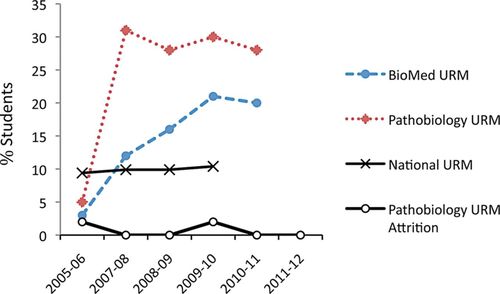
Figure 1. Change in URM student population in the Pathobiology graduate program and in the Division of Biology and Medicine. National URMs correspond to racial and minority PhD trainees enrolled in U.S PhD programs in nonagricultural biological sciences disciplines (NSF, 2012, Table 3-1). URMs include African Americans, Hispanics or Latinos/as, Native Americans, and Native Hawaiians or Other Pacific Islanders.
Institutional Partnerships to Enhance URM Recruitment and Student Access
Brown IMSD established partnerships with institutions serving significant numbers of UR students. The current institutional partners include: 1) York College, a small public college that is part of the City University of New York; 2) the Queens, New York, campus of St. John's University, a relatively large multicampus private university; and 3) North Carolina A&T State University, an HBCU (historically black college or university) that is part of the multi-institutional University of North Carolina system. All of these campuses have highly diverse undergraduate student populations. York College serves a population primarily of first-generation, college-going African-American and Hispanic students and was ranked 10th among the top 50 non-HBCUs awarding bachelor's degrees to black Americans. The Queens campus of St. John's University serves a broad constituent of racially and ethnically UR and non-URM socioeconomically disadvantaged students. North Carolina A&T serves a large URM student population who are primarily southern U.S. African Americans. These partner institutions are unique in that they do not represent the traditional high-profile HBCUs or Hispanic-serving institutions often viewed as the bellwethers of academic accomplishments. Our partners are, however, similar to these institutions in sharing the same mission of providing all students, regardless of race and background, the opportunity to develop their academic skills and talents en route to joining the domestic private and public U.S. workforce.
Activities that take place as part of the partner relationships are listed in Table 1. The partner relationships provide frequent opportunities to meet with and engage students from partner institutions at regional and national scientific conferences, as well as at their home institutions. The scope of interactions extends beyond the admissions season. The partnerships have facilitated connections via personal visits with undergraduates and master’s-level students at the partner institutions and groups of students at early stages in their training at Brown. As a result, the Brown IMSD program has been able to make students better aware of educational and career options available to them beyond their local communities. To sustain interinstitutional ties, Brown IMSD supports Brown faculty visits to partner institutions. In these settings, faculty engage students about research areas of interest, career aspirations, and expectations. Faculty also use these opportunities to demystify the PhD-training process and to introduce career options students may not have considered. These personalized engagements help to diminish persistent and widespread misconceptions about graduate school, such as the range of science career options available to PhDs and the financial costs associated with earning the degree. Over the past 3 yr, Brown IMSD has taken an active role in the curricular mapping process with partner institutions to improve pedagogical outcomes. The mapping process has helped to raise awareness about areas of weakness common to beginning graduate students, particularly inquiry analysis and problem-based learning. Faculty visits and regular communications developed as part of Brown IMSD have permitted the type of open exchanges with partner institutions crucial to this process.
| Activity | Goal | Frequency | Process |
|---|---|---|---|
| Graduate curricular mapping | Exchange of academic content aligning undergraduate and graduate curricula to improve student readiness for PhD studies and success | Semiannually | Meet, exchange, and share pedagogy with partner institution faculty. Current graduate students share experienced weaknesses and strengths of undergraduate preparation with their undergraduate institutions |
| Partners’ meeting | To advance work on enhancing and strengthening strategic partnerships and transforming culture of diversity | Annually | Faculty representatives from each institution spend 2 d at Brown, meeting with faculty (including graduate program directors), students, and administrators and attending classes and seminars. |
| IMSD program launch | Build stronger interinstitutional connections; build faculty bridges; assist partner institution faculty in monitoring the point-to-point maturation of their past students | Annually | Faculty representatives from partner institutions informally engage IMSD trainees, IMSD faculty, IMSD senior scholars, and administrators. |
| Partners’ Day | Provide partner institution students and faculty with firsthand experience on the Brown academic environment and its training climate for graduate students in the life, biomedical, and public health sciences | Annually | IMSD invites guests from partner institutions for a 1½-d visit to Brown to meet their past alums and other graduate students, attend seminars and classes, and visit research labs. Support for the visit is provided by the associate provost and director of institutional diversity. |
| Student relationship building | Build deeper and more lasting relationships with URM students starting in their freshman college year; maximize student opportunities for pursuit and success in science. | Annually | IMSD program director identifies students declaring interest in science and tracks them starting in their freshman year. Students meet with IMSD faculty on each visit to partner campus. |
| IMSD hosted socials | Cultivate and strengthen partner relationship; extend relationship beyond the admissions season | Annually | IMSD program hosts an informal social gathering of partner institutions’ students and faculty. |
Changing Applicant Pool Diversity
IMSD's ability to build cross-institutional connections with students at partner institutions has resulted in an increase in student applicants and matriculants to Brown graduate programs from these partner institutions. Since the start of the partner relationship, student representation from the partner institutions has gone from 0% of the total PhD student population to 3% of the total graduate student population. The start of the Brown IMSD program in 2008 heralded an aggressive and systematic effort to attract a diverse cohort of graduate students across Brown's nine graduate programs in biomedical and public health sciences. As shown in Figure 2, URM students accounted for 23% of all matriculating PhD students admitted to BioMed graduate programs in 2011–2012, compared with 17% during 2007–2008, the immediate pre-IMSD period. The rate of increase in the numbers of UR graduate applicants during the IMSD era, especially URM students, exceeded the rate of increase of non-URM applicants seeking admissions during the same period. For the 2011–2012 academic year, URM applicants accounted for 14% of all U.S. applications, compared with 11% during the most recent year of the pre-IMSD era (2007–2008).
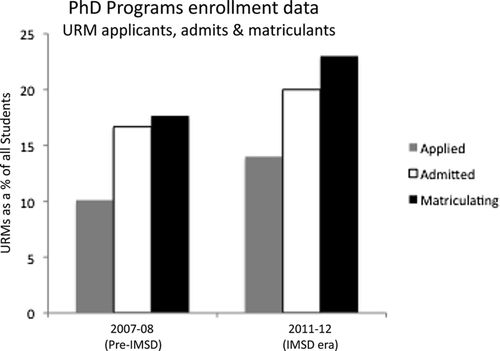
Figure 2. Comparison of URM student applicants, admitted students, and matriculants in BioMed graduate programs before and after implementation of the IMSD program. The figure shows URM students as a percentage of all PhD graduate students. Left, URM students applying to, admitted to, and matriculating in, respectively, PhD studies in 2007–2008, the year immediately preceding the start of the Brown IMSD program. Right, URM students applying to, admitted to, and matriculating in, respectively, PhD studies in 2011–2012, the most recent year of the IMSD era. Values are for racial and ethnic minorities and exclude other UR students applying to, admitted to, and matriculating in BioMed graduate programs.
Admitted-Student Qualifications
Aggregated data regarding matriculant credentials were evaluated as one measure of student quality. These analyses include grade point averages (GPAs) and Graduate Record Examination (GRE) scores (verbal and quantitative), which are summarized in Figure 3. Changes in GPAs of applicants to BioMed graduate programs since the start of the Brown IMSD program were evaluated, as shown in Figure 3a. Among the students admitted in 2011–2012, there was an expansion at both the high and low ends of the GPA ranges for all matriculating students. Despite the broadening of the GPA range among admitted students, the mean GPA for admitted students was 3.42 in 2011–2012, compared with 3.29 in 2007–2008. The low end of the GPA range of admitted URM students during the IMSD era did not differ from the value for URM students admitted in the pre-IMSD era. URM students applying to, admitted to, and matriculating in BioMed graduate programs during the IMSD era, however, no longer define the low end of the GPA range of applicants, admitted students, or matriculants. These changes reflect positively on our diversity efforts and are in line with the goals of the IMSD program.
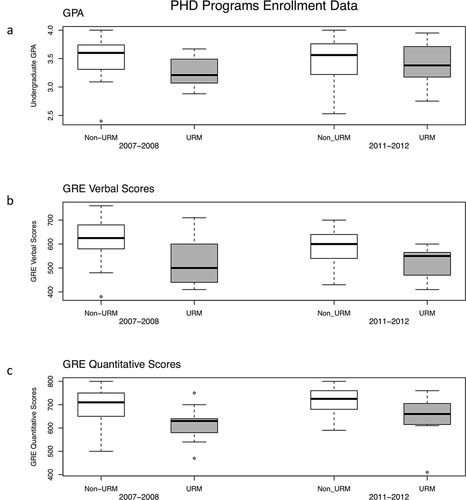
Figure 3. Box-and-whisker plots of (a) undergraduate GPAs and (b) verbal and (c) quantitative GRE scores of matriculants to PhD-training programs of BioMed. GPA and GRE scores are presented for admitted URM (shaded boxes) and non-URM matriculants (open boxes) for 2007–2008 (pre-IMSD) and 2011–2012 (the most recent IMSD year). (a) The mean GPA for students admitted in 2007–2008 was 3.29 vs. 3.42 for students admitted in 2011–2012. (b) Verbal GRE scores for URMs matriculating in 2007–2008 ranged from 410 to 710 among a total matriculating pool with a range of 320–760. The 2011–2012 URM matriculants had a verbal score range of 410–690 in a total pool range of 350–700. (c) In the 2007–2008 academic year, URM matriculant quantitative GRE scores ranged from 470 to 750 among a matriculant pool whose quantitative scores ranged from 470 to 800. URM students admitted in 2011–2012 had a quantitative score range of 410–760 among a matriculating pool with a range of 410–800.
GRE verbal score data are shown in Figure 3b. Verbal scores for URMs matriculating in 2007–2008 ranged from 410 to 710 among a total matriculating pool with a range of 320–760. This compares with the 2011–2012 URM matriculants, who had a verbal score range of 410–690 in a total pool with a range of 350–700. The verbal score range over which non-UR students perform is thus broad and encompasses the score range for UR students. The 2011–2012 GRE verbal score ranges for both URM and non-URM matriculants has narrowed, with much of the change in range taking place at the higher end of the range.
Data for the GRE quantitative exam are shown in Figure 3c. For the 2007–2008 academic year, scores ranged from 470 to 750 for URM matriculants among a matriculant pool whose quantitative scores ranged from 470 to 800. In comparison, URM students admitted in 2011–2012 had a quantitative score range of 410–760 among a matriculating pool with a range from 470 to 800. For 2011–2012 URM and non-URM matriculants, the low end of the GRE quantitative score range was markedly lower than for matriculants admitted during 2007–2008, the most recent pre–IMSD era admissions period. This change likely reflects the increased confidence Brown graduate programs place in the ability of Brown IMSD to address weaknesses in the quantitative skills of students who begin their graduate training. There is also only a negligible increase at the high end of this range. Although the quantitative score ranges have broadened, the average score for all matriculants increased from 620 for 2007–2008 matriculants to 645 for 2011–2012 matriculants. URM matriculants were not the sole determinants of the low end of the quantitative score range of matriculating students.
URM applicants did not define the low end of the ranges in either the applicant or accepted applicant pools for the verbal, the quantitative, or the analytical (unpublished data) components of reported GRE scores. GRE test scores in general vary widely among graduate applicants, and they are often difficult to correlate with student abilities and future success in graduate school (Morrison and Morrison, 1995; FairTest, 2007). Anecdotally, this has been found to be the case for many past applicants to our graduate programs, regardless of their background.
Despite the changes observed in score ranges, analysis of adjusted p values using the Benjamini and Hochberg method for URMs admitted during the pre-IMSD era versus URMs admitted during the IMSD era shows that there is no statistical difference in the average GPAs and average GRE scores of admitted students. This analysis, however, does not fully reveal the details of the students admitted. A careful examination of the average GPAs and GREs of students admitted in the IMSD era shows that the absence of statistical change is the result of graduate programs matriculating students that have numerical GPA and GRE scores higher than students admitted in the pre-IMSD era, as well as simultaneously matriculating students with scores weaker than scores of students admitted in the pre-IMSD era. While GRE scores may not be useful predictors of student success, they may be more useful as diagnostic tools that identify gaps that need to be addressed. Students admitted to graduate studies who performed poorly on one part of the GRE are given supplemental module training in their first year at Brown. Specifically, graduate students performing poorly on the quantitative portion of the test are enrolled in IMSD skill-based modules designed to strengthen their quantitative skills. Similarly, students performing poorly in writing enroll in modules that strengthen writing skills.
Personalized Student Support to Enhance Student Academic Success
Academic and research knowledge gaps of students beginning graduate training at Brown are addressed using 11 not-for-credit, skill-based training modules developed by the Brown IMSD program. The active-learning process of each module provides structured training exercises as preludes to formal course work and other training experiences. The current menu of modules, learning objectives, and competencies addressed is listed in Table 2 and the Supplemental Material. Although initially designed to address the needs of UR students, the value of these modules has become widely accepted as useful training tools for all graduate students. Each year, more than 20% of the BioMed graduate student population takes at least one module, and ∼74% of all module subscribers are not IMSD-supported graduate students. Additional module subscribers include visiting faculty and postdoctoral fellows. Anonymous surveys conducted at the conclusions of modules reveal a high degree of satisfaction with the material covered and its perceived benefit to participants (unpublished data). The high level of enrollment by all students and involvement of faculty from all BioMed graduate programs as module leaders have pre-empted the perception of modules as “remedial” or otherwise associated with negative stigma.
| Module | Content or purpose |
| Demystifying the PhD Experience: Strategies for Academic & Personal Success in Grad School | Become aware of and develop strategies to implement and fully integrate the academic and nonacademic skills required to succeed in graduate school |
| Beyond the Hypothesis: Experimental Design & Critical Analysis | Develop skills in mechanistic hypothesis setting and experimental design |
| Designing and Delivering Scientific Presentations | Gain insight and practice in effective oral communications of scientific results |
| Defending Your Research Proposal & Critiquing Those of Others | Strategies in selecting a strong thesis topic; evaluating your progress; giving and receiving advice |
| Resources, Tools and Basic Techniques in Molecular Biology | Gain insight into when to apply particular methods and resources for genomic/proteomic approaches |
| Professionalism: Maximizing Your Impact in Professional Settings | Recognize and acquire behaviors that promote career success in biology and public health |
| Scientific Presentation of Biological Data | Learn how to construct effective graphs that maximize meaningful content and interpretation |
| Scientific Writing: Key Principles | Learn strategies to effectively communicate in writing the what, why, how, and outcomes of your work |
| Introduction to Statistical Analysis of Data | Gain familiarity with statistical software and when to apply them in analyzing your data |
| Reading Scientific Publications | Develop skills in interpreting, critiquing, understanding, and appreciating journal articles in your field |
| Essential Laboratory Calculations | Pointers on accuracy, following protocols, and making measurements that are critical to experimental success and reproducibility |
Milestones to Evaluate Progress
During the IMSD era, all nine BioMed graduate programs have now been successful in matriculating UR students (Figure 4). Given the challenges of admitting UR students to programs in which they are underrepresented, this success reflects the effectiveness of institutionalizing good practices.
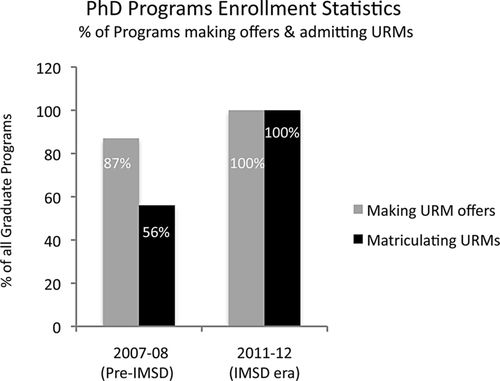
Figure 4. Comparison of enrollment of URM PhD students among the nine BioMed graduate programs. The number of graduate programs making offers of admission to URM students in the pre-IMSD era (2007–2008) compared with programs making offers in the most recent year of the IMSD program (2011–2012). Also shown are the program success rates for being able to matriculate URM students. Matriculating students represent those to whom offers were made and who subsequently enrolled in graduate training at Brown.
The Brown IMSD program is entering its fourth year of operation, and the number of trainees who have advanced to the preliminary examination or thesis defense is therefore too low to utilize as a measure of IMSD success. Several measurable milestones prior to the preliminary examination are used to assess student trajectory and simultaneously evaluate the effectiveness of IMSD practices. These milestones have been particularly useful in early assessment of the achievements of IMSD-supported students relative to their peers and in evaluating the readiness of these trainees for NIH T32 support. A comparison of the achievements of IMSD trainees with those of a group of non-IMSD trainees is summarized in Table 3. To avoid overrepresentation by some graduate programs that have student populations three to five times larger than other programs, Table 3 shows data for matched cohorts of students before and after implementation of the IMSD program. Measures of trainee achievements include publications on which trainees are listed as coauthors, securing of federal or national predoctoral fellowships, research presentations at scientific conferences, and receipt of nonminority travel awards. Calculations for the past 3 yr are based on data for six of the nine BioMed PhD programs, because these were the programs matriculating IMSD trainees during this period. The results show that IMSD-supported trainees publish at a rate greater than pre–IMSD era URM trainees and that they publish at a rate comparable with their contemporary non-URM peers.
| Measures of student achievementa | |||||
|---|---|---|---|---|---|
| Training period | Trainee status | Cohort publicationsb | Fellowship awards | Scientific research presentationsc | Travel awardsd |
| Pre–IMSD era (2005–2007) | URM: No IMSD support | 0 | 3 | 1 | 1 |
| Non-URM | 4 | 1 | 11 | 0 | |
| IMSD era (2008–2011) | URM: IMSD support | 15 | 6 | 20 | 4 |
| Non-URM | 18 | 9 | 25 | 4 | |
IMSD-supported trainees were also awarded federal and other national fellowships at a rate greater than pre–IMSD era URM trainees. Although pre–IMSD era URM trainees received more travel awards than their non-URM, pre–IMSD era counterparts on a percentage basis, trainees supported during the IMSD era received more total travel awards than their pre–IMSD era counterparts. The absolute values in Table 3 presented for pre–IMSD era trainees are smaller than the values for the IMSD era, and the variables responsible for these differences are unknown and potentially complex. However, a comparison of ratios between URM and non-URM trainee achievements in 2005–2007 versus ratios between IMSD era–supported trainees and non-URMs in 2008–2011 shows that IMSD trainees perform at rates comparable with their non-URM peers during the IMSD era. This is in contrast to the performance of URM trainees relative to their non-URM peers in the period prior to the IMSD program. Only in terms of total travel awards and fellowships received did pre–IMSD era URM trainees do better than their IMSD-era URM peers. In terms of absolute values, however, IMSD-era URM trainees perform better than their pre–IMSD era counterparts. While the total number of trainees examined here is small, and the period of analysis is too short to define a clear pattern, the results reveal a trend that shows improvements in UR student performance correlating with IMSD program support and practices. These findings are also supported by statistical analysis. Fisher's exact test shows that the increase in cohort publications among URM trainees during the IMSD era is significant, with a two-sided p value of 0.1314. The same type of analysis reveals that the increases in URM scientific presentations is also significant, with a two-sided p value of 0.0399. Despite increases in absolute numbers, however, there is no statistical significance in the increase of fellowships or travel grants awarded to URM students during the IMSD era for the cohort studied.
IMSD trainees are expected to demonstrate competency and progress in their graduate research and to develop their own research training plans. All are required to complete written quarterly or annual assessment of progress in graduate research competency, and these work products are used as foundations for preparing predoctoral fellowship applications for external support. This practice is shared widely with all graduate programs, as it is applicable to both URM and non-URM students. Figure 5 summarizes information gathered from NIH RePORTER (projectreporter.nih.gov/reporter.cfm). It shows that since the start of the IMSD era in 2008, a significant number of new NIH F-series predoctoral fellowships have been awarded to PhD trainees in BioMed. A number of these have been awarded to IMSD trainees. IMSD trainees and other students supported by the program have also secured additional fellowships from the Ford Foundation and the NSF at levels that exceed those previously secured by URM students in the pre-IMSD era (unpublished data). As shown in Figure 5, from 2008 to 2011, a total of 33 new F-series fellowships were awarded to Brown graduate students, and 10 of these were awarded to URM trainees. This is in addition to fellowships from NSF and other sources. The year 2011 also coincided with the period of “funding saturation,” such that the maximum number of students who could apply and needed to apply for external fellowship support had been reached. As a result, we see a modest decrease in the numbers of new fellowships in 2011–2012 when compared with the 2009–2010 and 2010–2011 years.
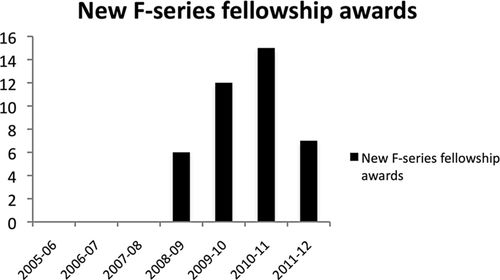
Figure 5. New F-series fellowships awarded. In 2005, 10 new F-series fellowships were awarded to graduate students or postdoctoral fellows in the BioMed division at Brown University. This value is set as a baseline of 0, and new fellowships awarded in subsequent years are incremental to this baseline. The 2008–2009 year corresponds to the start of the Brown IMSD program and its practices throughout the BioMed division.
Faculty Engagement Driving Changes in Institutional Culture
Brown IMSD assists graduate programs in identifying UR students as prospective trainees in training programs in which they are greatly underrepresented. Incentives provided in the form of increased program resources encourage graduate programs to identify and recruit promising UR students as graduate students. A large number of graduate faculty have become involved in IMSD activities, including leadership of training modules, service on the IMSD advisory board, participation in institutional partnership activities, and mentoring of IMSD trainees (Table 4). The success of partnership-building relationships is driven by the willingness of faculty to take active roles in sustaining these partnerships. While the activation energy for engagement can be high for some faculty, those involved recognize the value and benefits in supporting these relationships and building connections with prospective graduate students. Engagement of UR students by non-UR faculty allow the faculty to better understand the basis of assumptions many of these students make with regard to earning PhD degrees and the perceived value of the degree. Non-UR faculty also gain an appreciation that student motivation to engage in research and enter research careers may be dampened by family or cultural demands and perceptions of limited career options in the sciences. Training modules, which were initially viewed as extracurricular distractions that take away from important graduate work, have now received full “buy-in” from faculty, who recognize the merits of training modules as early intervention tools and encourage enrollment of both UR and non-UR students. An increasing number of faculty serve as module leaders, as they recognize that their involvement helps students develop critical-thinking abilities and analytical and writing skills.
| Category/role | Participant number |
|---|---|
| Skill-based module leaders | 23 |
| IMSD advisory board member | 18 |
| IMSD mentors/trainers | 28 |
| Graduate program diversity liaison/contact | 4 |
| Outreach faculty (attends SACNAS and ABRCMS)b | 4 |
| Partner institution–hosted visitor/guest | 3 |
IMSD also leverages its position to secure institutional support for faculty to attend scientific meetings at which large numbers of UR students present their research. This is used as a mechanism to identify and cultivate applicants for graduate admissions. Interest in fields such as ecology, in which UR students are very much underrepresented (Holland et al., 1992), can be stimulated when science is shown to be integrative and interdisciplinary. Brown IMSD supports a seminar series to invite speakers who engage in interdisciplinary and integrative scientific research. These speakers are cosponsored by graduate programs and draw speakers and audiences from diverse fields. Using our seminar series to illustrate the interdisciplinary nature of science has helped to stimulate greater interests among UR students in pursuing graduate training in areas in which they have been historically absent.
Increasingly, Brown IMSD works with graduate-training faculty to further promote the academic development of IMSD trainees to help them transition from IMSD support to other support mechanisms. This work involves identifying and preparing trainees for unique training experiences offered by T32 institutional training awards. This collaborative work has been valuable in increasing diversity among T32 trainees and has served as a model for a number of training faculty as they establish new training foci to be supported by institutional training awards. Figure 6 summarizes the change in the number of institutional training awards to Brown in relation to the establishment of the Brown IMSD program. In most of these awards, IMSD has been identified as either an important partner program or as a resource to support the programs. The data for both F-series fellowships and NIH T32 institutional awards, although correlative, point to the clear institutional benefits of IMSD practices at Brown and the wider success of graduate programs that embrace diversity.
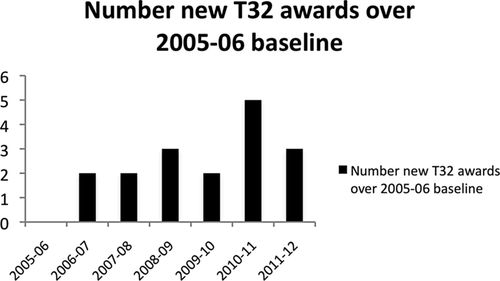
Figure 6. Number of new T32 training grants awarded above the 2005–2006 baseline. In 2005, 11 NIH T32 and T35 training grants were available to the BioMed division at Brown University. The figure shows new incremental training grants above these 11, as shown for 2006–2007, when two new training grants were awarded to the division.
In summary, we have approached our goal of increased graduate program diversity and student success across the BioMed division by systematically applying practices that were utilized by one highly diverse graduate program. Early outcome data are encouraging and suggest that these practices contribute to increased diversity across biological and public health graduate programs. In Figure 7, we incorporate the three major IMSD practices described in this report—strategic institutional partnerships, personalized student support, and faculty engagement—to form a working model for URM retention and success, with the hope that this model may serve as a basis for further research and efforts in diversifying the graduate ranks. Because each practice is relatable to the other two and can impact its success, it is recommended that all be developed in concert to achieve maximal results.
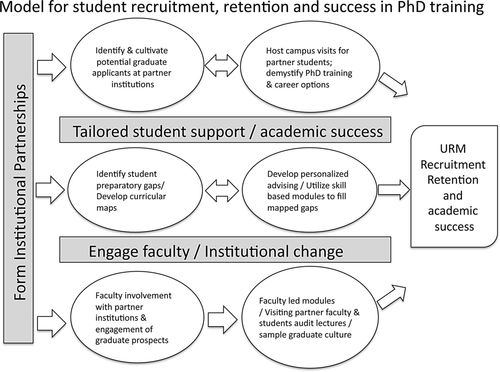
Figure 7. Working model for increasing retention and success in PhD training. The model highlights specific practices (ovals) that are key components of the Brown IMSD program and their relationship to the three broad interventions and associated goals (shaded boxes) investigated in this study. Double-headed arrows between some practices indicate reciprocal effects. The vertical box for “Form Institutional Partnerships” conveys the cross-cutting nature and interplay of practices directed toward this intervention.
DISCUSSION
This report shows that it is possible to achieve a level of diversity in the sciences that approaches the general level of diversity of the U.S. population. We document program practices designed to improve the success of UR students in the graduate training environment and provide short-term outcome data. The early outcomes of our program show a positive correlation with URM retention and student achievements. Although the statistical significance of some practices may appear small as we report this early data assessing the impact of the IMSD program, these practices are of great practical significance with regard to diversity and in changing the institutional climate and culture at Brown. Our institutional partnerships have aided URM student recruitment via both student–faculty and faculty–faculty interaction. Student support, provided through skill-based training modules and regular monitoring of academic progress through advisement and mentoring, has aided student transition from the undergraduate level to the graduate level and success in the graduate ranks. Underrepresented racial and ethnic minority students have long been documented to be underprepared for graduate training (Summers and Hrabowski, 2006). One of the root causes for this continues to be their lack of access to resources that are often more readily available to their majority counterparts (Aud et al., 2010). However, gaps in preparation for graduate study are not unique to URM students. Both UR and non-UR students have utilized our training modules to fill these gaps. Faculty involvement in Brown IMSD, especially in leading skill-based modules and interacting with students and colleagues at partner institutions has led to shared values in diversity across our nine PhD programs. In turn, our graduate programs are now all succeeding in attracting and retaining high-quality URM students.
While we do not suggest that the strategies described here are unique to Brown, these practices, in combination with senior administration support, have been successful in advancing diversity and student success in our training environment. The practices described here are generalizable and can be expected to lead to similar outcomes when applied elsewhere. As a result, we look forward to seeing measurable advances in the representation of racial, ethnic, and other disadvantaged individuals in the scientific workforce.
FOOTNOTES
1The Harriet W. Sheridan Center for Teaching and Learning (http://brown.edu/Administration/Sheridan_Center) provides and supports a range of pedagogical approaches to teaching and offers support to all members of Brown's teaching community. The center also recognizes the diversity of learning styles and uses a number of mechanisms to encourage reflective, independent, lifelong learning on the Brown campus.
ACKNOWLEDGMENTS
This work is supported by 1R25GM083270-01 and 1R25GM083270-01S1 from the National Institute of General Medical Science to N.L.T. and A.G.C. We thank Tracey Cronin, Michele Curry, and Karen Ball for data tracking and analysis and Dr. Elizabeth Harrington for access to divisional information. We also thank Dr. Xi Rossi Luo and Allison Delong for statistical analysis. We further acknowledge the commitment of our institutional partner leaders Drs. Gerry McNeil, (York/City University of New York), Chris Bazinet (St. John's University, New York), and Mary Smith (North Carolina A&T State University).


